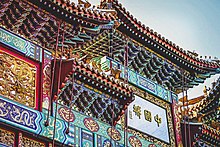友谊牌坊 (华盛顿哥伦比亚特区)
| 友谊牌坊 | |
|---|---|
| Friendship Archway | |
 The gate, facing east from 7th and H into Chinatown; photographed by Carol Highsmith c.1986 | |
| 經緯度 | 38°53′59″N 77°01′18″W / 38.89982°N 77.021692°W |
| 位置 | 675 H St NW |
| 設計者 | Alfred H. Liu |
| 開放 | 1986年11月20日 |
| 恢復 | 1993年, 2009年, 2019年 |
友谊牌坊(英語:Friendship Archway)是一座设置于美国华盛顿特区唐人街入口处的中式牌坊建筑[1]。该牌坊是中国以外所建造的最大牌坊式建筑之一。
历史
[编辑]该牌坊的建造规划始于1984年,由华盛顿特区新宣布的友好城市北京共同资助。但牌坊所在地唐人街的大部分反共人士不同意中国大陆的参与并提出抗议[2]。
1985年,当地建筑师Alfred H. Liu设计了友谊牌坊,此前市政府官员拒绝了在整个唐人街放置12个较小的拱门(每个拱门都装饰有十二生肖动物当中的一种)的提案[3]。Liu曾于1982年设计了华乐楼(Wah Luck House)[4]:3,一栋低收入阶层的高层建筑住宅,以满足美国住房和城市发展部要求的三天设计时间,七周建造时间的底线[3]。他还是唐人街发展公司的董事长,十几岁时从台湾移民到美国[5]:§7:9。
On November 20, 1986, the city dedicated the traditional Chinese gate;[6] the signatures of Mayors Marion Barry (of Washington DC) and Chen Xitong (of Beijing) are engraved on the dedication plaque at the monument's base. Meanwhile, the local Chinese Consolidated Benevolent Association announced plans for a second privately-financed gate at the neighborhood's eastern border, near 5th and H, although the financing fell through later.[2][7]
Erected to celebrate friendship with Washington's sister city of Beijing,[3] it was hoped the arch would reinforce the neighborhood's Chinese character. It was recognized as the largest such single-span archway in the world by The Guinness Book of Records after its completion.[4]:21

However, by 1990, tiles had begun to fall from the roof, and in June of that year, a passing soda truck struck the head of a dragon, prompting the Department of Public Works to remove the tiles and ornaments. Because the tiles were set in October 1986, the cold temperatures may not have allowed the mortar to set properly.[8] In 1993, the Friendship Archway underwent a major renovation funded by D.C. and Chinese governments. Artisans from China performed extensive repairs on the archway and repainted its decorations.[9]
In 2020, it underwent restoration for faded and peeling paint and tiles.[10]
设计
[编辑]
The colorful, US$1 million work of public art includes seven roofs covered in 7000 tiles and 284 dragons (272 painted and 12 carved) in the style of the Ming and Qing dynasties. It spans H Street just east of 7th, standing 47英尺7英寸(14.50米) tall and 75英尺(23米) wide. In total, it weighs 128 short ton(116 t), of which 63 short ton(57 t) are in the roofing and decorations; the supports and internal structure are made from 27 short ton(24 t) of steel and 38 short ton(34 t) of concrete.[9]
The width of the span is enabled by a concealed steel beam; without it, the arch would be narrower.[5]:§8:19 [7] Decorative components were supplied by the Beijing Ancient Architectural Construction Corporation.[2]
Friendship Archway bears the Chinese characters for Chinatown ((中文), read from right to left) on the panel just below the centermost roof.
参见
[编辑]参考文献
[编辑]- ^ 友谊牌坊, Washington. cityseeker. [2024-07-19] (中文).
- ^ 2.0 2.1 2.2 Allen-Kim, Erica. The Political Economy of Chinatown Gates. Pidgin. No. 15 (Princeton University School of Architecture). Spring 2013 [29 April 2020]. (原始内容存档于2021-06-24).
- ^ 3.0 3.1 3.2 Taylor, Tim. Chinatown Advocate Recalls the Good Fight. Roll Call. February 20, 2009 [29 April 2020]. (原始内容存档于2023-12-11).
- ^ 4.0 4.1 AEPA Architects Engineers. Chinatown Design Guidelines (PDF) (报告). Office of Planning, Government of the District of Columbia. 1989 [29 April 2020]. (原始内容存档 (PDF)于2024-06-13).
- ^ 5.0 5.1 Miller, Rebecca. Historic Preservation Review Board, Application for Historic Landmark or Historic District Designation: Downtown Historic District (boundary increase) (PDF) (报告). United States Department of the Interior, National Park Service. January 2013 [29 April 2020]. (原始内容存档 (PDF)于2021-10-20).
- ^ Friendship Archway, (sculpture).. Smithsonian Institution Research Information System. [18 February 2011]. (原始内容存档于2023-11-06).
- ^ 7.0 7.1 Forgey, Benjamin. Archway of Triumph. The Washington Post. January 31, 1987 [29 April 2020].
- ^ Hsu, Evelyn. For friendship's sake, Chinese artisans come to mend archway. The Washington Post. August 26, 1993 [29 April 2020].
- ^ 9.0 9.1 DeFerrari, John. Chinatown's Friendship Archway. Greater Greater Washington. February 9, 2011 [September 30, 2012]. (原始内容存档于2022-09-11).
- ^ Parker, Don. D.C.'s iconic Chinatown Friendship Arch has been restored. WJLA. November 18, 2020 [23 November 2020]. (原始内容存档于2024-01-21).

